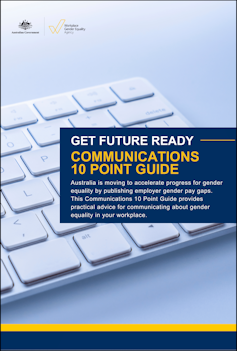There will be nervous executives all over Australia this week.
Come Tuesday, large private sector organisations will have their company’s gender pay gaps published for the first time for all to see, name, and shame.
As they brace for the fallout, let’s look at how what we will be told is changing, and what it will mean for you.
What is changing?
Every year, the Workplace Gender Equality Agency (WGEA) collects information from every employer with more than 100 employees. Until now it has published only a summary of the findings on its website, including Australia’s overall gender pay gap, and the gap by industry and employment arrangement.
But for the first time legislation enacted last year also allows WGEA to publish the gender pay gaps of individual employers.

Tuesday’s release will include each large company’s median gender pay gap, and the share of women it employs in lower- and higher-paid jobs.
Employers will have the chance to publish a statement alongside their results to provide context.
That means from Tuesday you will be able to look on the WGEA website and find the median gender pay gap of your large private sector organisation, or of an organisation you are thinking of joining, and how it stacks up against its competitors.
Why the change?
Australian women, like women elsewhere, have made astounding progress in the workforce in recent decades.
Women are both working and earning more than ever before. But progress has stalled, and the gender pay gap remains stubbornly persistent.
The Albanese government has shown its commitment to gender equity by increasing the childcare subsidy and extending paid parental leave.
But beyond this, the options for governments are limited. Most of the barriers to women getting better-paid jobs can only be broken by employers.
The public naming and shaming that will begin on Tuesday will push accountability onto employers, holding them responsible for the conditions in their workplaces.
Read more: Four big lessons from the UK's new gender pay gap reporting rules
Workers and bosses are going to take notice: when employer gender pay gaps were released in the UK in 2018 it was the biggest business news story of the year, with coverage rivalling the wedding of Prince Harry and Meghan Markle.
At a time when companies are fighting for top talent, it is going to make it more difficult for employers with large pay gaps to hire talented women.
Research shows that on average women are willing to accept a 5% lower salary in order to avoid working for the employers with the biggest gender pay gaps.
Let’s not rush to judge
While naming and shaming will help make this policy effective, we should be careful about rushing to judgement.
It is possible for an employer to be making serious efforts to improve while its gap remains large.
And some actions aimed at improving things, such as implementing a gender quota on entry-level positions, can worsen a company’s apparent gender pay gap in the short term by temporarily increasing the number of lowly-paid women.
Also, there will be firms that have a low gender pay gap because they pay both men and women poorly.
On Tuesday, we should instead look closely at whether the organisation has outlined clear steps it will take to improve, and how it compares to its competitors. In future years, we will be able to see how things have changed.
What will matter is what employers do next
Since the UK reforms were introduced in 2018, the gender pay gap has narrowed by one-fifth, with the biggest improvements coming from the worst offenders.
UK companies have also become more likely to include wage information in their job ads, equalising the starting point of wage negotiations for all applicants.
But for existing employees, the narrowing of the gap has been caused more by slower growth in men’s wages than faster growth in women’s wages, which isn’t good news for anyone looking for a pay rise.
The full effects of the Australian reforms won’t be seen for some time.
It is likely that making high-paid jobs more accessible to women will allow employers to tap into a new talent pool and encourage more highly credentialed women into the workforce, adding to productivity growth.
What is clear now is that if we want to narrow the gender pay gap, we need to know what’s happening. The avalanche of data due on Tuesday will be a start.

